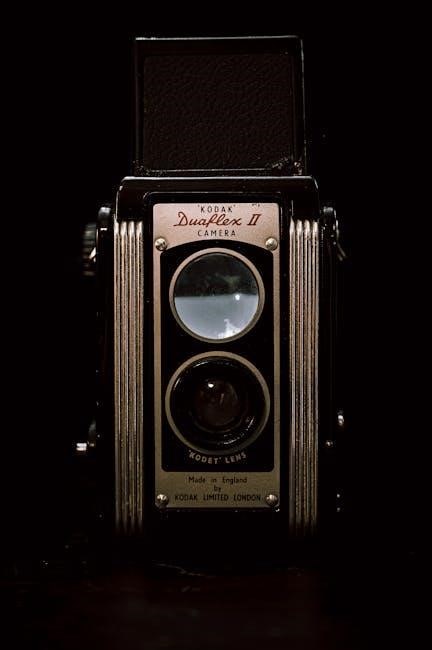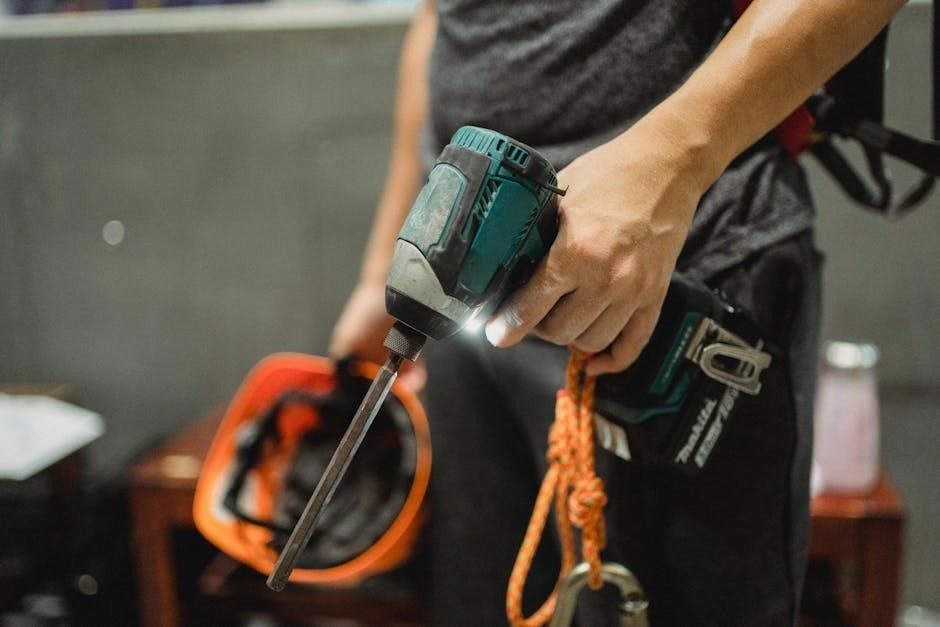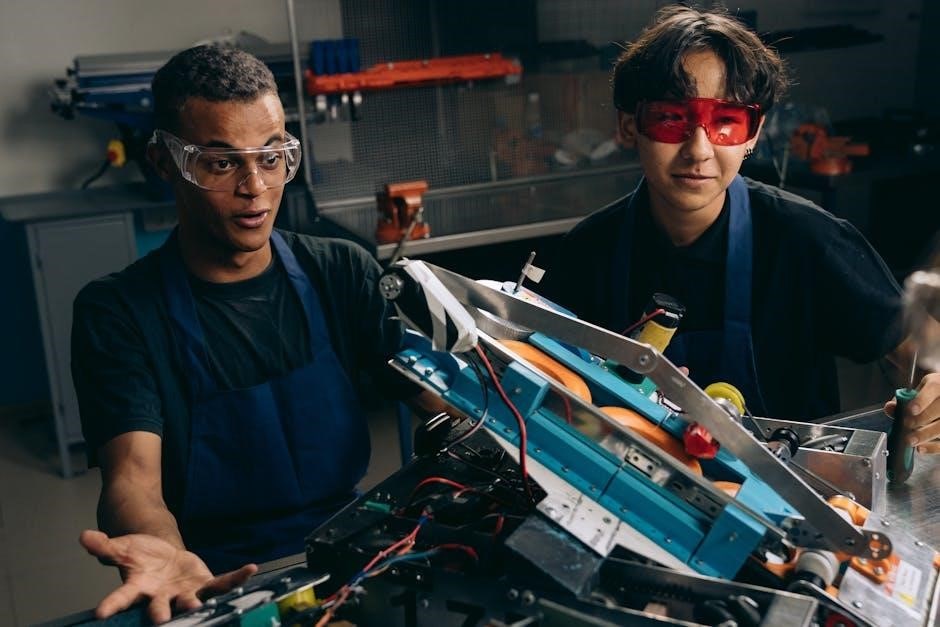1․1 Definition and Purpose
Manual suction devices are portable tools designed for removing fluids or debris in medical settings, essential for maintaining airway patency and ensuring patient breathing․
A manual suction device is a portable, non-electric tool used to remove fluids, mucus, or debris from a patient’s airway․ Its primary purpose is to maintain airway patency, ensuring proper breathing and preventing respiratory complications․ These devices are commonly utilized in medical settings, particularly for patients who cannot clear their airways independently, such as those undergoing surgery, tracheostomy, or experiencing severe respiratory conditions․ The device operates by generating negative pressure, either through a handheld pump or bulb syringe, to extract secretions․ Its simplicity, reliability, and portability make it an essential tool in both clinical and emergency situations, providing immediate and effective airway clearance․ The manual suction device plays a critical role in patient care, particularly when electric-powered options are unavailable, ensuring timely and life-saving interventions․

History of Manual Suction Devices
Manual suction devices have evolved from basic handheld tools to sophisticated designs, reflecting advancements in medical technology and their critical role in airway management․
2․1 Origins and Early Development
Manual suction devices trace their origins to the mid-19th century, evolving from rudimentary tools used to clear airways․ Early models were simple, often employing a bulb or piston mechanism to create suction․ These devices were primarily crafted from metal or rubber, materials that offered durability and ease of sterilization․ The late 1800s saw the introduction of hand-operated suction devices, which became indispensable in medical settings for removing fluids and debris․ Their design was influenced by the growing understanding of respiratory physiology and the need for reliable airway management․ By the early 20th century, manual suction devices had become a standard tool in hospitals, particularly during surgeries and emergency procedures․ Their development reflects the convergence of medical necessity and engineering innovation, laying the groundwork for modern, portable suction systems․
2․2 Historical Applications
Manual suction devices have historically played a crucial role in medical and industrial settings, serving as essential tools for removing fluids, debris, and contaminants․ In early medical practices, these devices were primarily used to clear airways during surgeries and respiratory distress cases․ During World War I and World War II, portable suction devices became vital in military medicine, aiding in the treatment of wounded soldiers by maintaining airway patency․ Beyond healthcare, manual suction devices were also utilized in laboratories and industrial environments for handling hazardous materials and chemical spills․ Their reliability and simplicity made them indispensable in scenarios where electricity was unavailable or impractical․ Over time, their applications expanded into veterinary medicine for animal care and emergency response situations, solidifying their importance as versatile tools in maintaining safety and hygiene across diverse fields․

Types of Manual Suction Devices
Manual suction devices include handheld, foot-operated, and bulb syringe models, each designed for specific applications in medical, laboratory, or industrial settings to remove fluids or debris efficiently․
3․1 Handheld Suction Devices
Handheld suction devices are compact, portable tools designed for precise fluid or debris removal․ Lightweight and easy to maneuver, they are ideal for medical professionals in emergency or clinical settings․ These devices often feature adjustable suction power, allowing customization for patient-specific needs․ Their ergonomic design ensures comfortable use during prolonged procedures․ Common applications include oral suctioning, wound care, and airway management․ Handheld suction devices are valued for their portability and reliability, making them essential in both hospital and outpatient environments․ They are also cost-effective and require minimal maintenance, contributing to their widespread use in healthcare settings․ Their versatility and ease of operation make them a critical tool for ensuring patient safety and comfort during various medical procedures․
3․2 Foot-Operated Suction Devices
Foot-operated suction devices are larger, floor-based units designed for heavy-duty use in medical settings․ They are typically powered manually or electrically and feature a foot pedal for hands-free operation․ These devices offer higher suction power compared to handheld models, making them ideal for complex procedures requiring continuous suction․ Their robust design ensures durability, and they are often equipped with large collection chambers for extended use․ Foot-operated suction devices are commonly used in surgical environments, trauma care, and intensive care units․ They provide consistent performance and are preferred for scenarios involving significant fluid or debris removal․ Their stability and power make them indispensable in situations where reliability is critical․ However, their size and weight limit portability, making them more suitable for stationary medical facilities․ Regular maintenance is essential to ensure optimal functionality and patient safety․
3․3 Bulb Syringe Suction Devices
Bulb syringe suction devices are simple, manually operated tools used to remove fluids or debris from a patient’s airway․ They are widely used in medical settings, particularly in neonatal and emergency care․ The device consists of a squeezable bulb attached to a suction catheter, which creates negative pressure when compressed․ This allows for effective removal of secretions or blockages․ Bulb syringe suction devices are portable, easy to use, and require no external power source, making them ideal for situations where electricity is unavailable․ They are also cost-effective and disposable, reducing the risk of contamination․ However, their suction power is limited compared to other manual suction devices, and they are best suited for small-scale or temporary use․ Despite these limitations, they remain a vital tool in healthcare for quick and reliable suction needs․

Applications of Manual Suction Devices
Manual suction devices are primarily used in medical settings to clear airways, removing fluids or debris to ensure patient breathing․ They also assist in laboratory settings for handling small liquid samples․
4․1 Medical Applications
Manual suction devices are indispensable in medical settings for clearing airways, removing fluids, and ensuring patient breathing․ Widely used in hospitals, clinics, and emergency care, they are essential for patients with respiratory issues who cannot cough effectively․ These devices prevent complications like asphyxiation or infections by efficiently removing mucus and secretions․ They are also employed during surgeries to maintain a clear surgical site and in neonatal care for safely aspirating newborns․ Their portability and reliability make them critical in emergency situations where power sources are unavailable․ Additionally, they are used in intensive care units (ICUs) for critically ill patients and in home care settings for individuals with chronic respiratory conditions, enabling continuous care and improving quality of life․
4․2 Laboratory and Industrial Applications
Manual suction devices also find extensive use in laboratory and industrial settings, where precise fluid or debris removal is necessary․ Laboratories utilize these devices for aspirating liquids during experiments or cleaning sensitive equipment․ In industrial environments, they are employed for spill cleanup, maintaining equipment, and ensuring a safe working environment․ Their portability and reliability make them ideal for applications where electricity is unavailable or impractical․ Additionally, these devices are used in manufacturing processes for handling hazardous materials or in quality control inspections․ Their versatility allows them to adapt to various industrial needs, from small-scale workshops to large production facilities, ensuring efficiency and safety in operations․ This makes manual suction devices indispensable tools in both laboratory and industrial contexts, contributing to operational efficiency and safety standards․

Design and Components
Manual suction devices feature a simple, portable design with a collection chamber and one-way valve․ They operate via handles or foot pedals, enabling effective fluid removal․
5․1 Overview of Design
Manual suction devices are designed for portability and ease of use, typically featuring a compact, lightweight construction․ Their design includes a collection chamber to hold fluids, a one-way valve to prevent backflow, and a handle or pedal for operation․ The devices are crafted from durable, easy-to-clean materials, ensuring hygiene and longevity․ The simplicity of their mechanism allows for reliable performance without the need for external power sources․ This design makes them ideal for emergency situations or settings where electricity is unavailable․ The overall structure prioritizes functionality, with intuitive controls that enable quick and effective suction․ Additionally, some models include adjustable suction strength, catering to varying clinical needs․ The ergonomic design ensures comfort during use, reducing fatigue for healthcare professionals․ These features collectively contribute to their effectiveness in medical and emergency applications, providing a vital tool for maintaining airway patency and patient care;
5․2 Key Components
Manual suction devices consist of several essential components designed to facilitate effective suction․ The primary elements include a durable collection chamber to store aspirated fluids, a one-way valve to prevent backflow, and a lightweight, ergonomic handle or foot pedal for easy operation․ The device also features a flexible tubing system to connect the suction source to the collection chamber․ Additionally, some models include adjustable pressure controls to regulate suction strength, catering to different clinical requirements․ The components are typically constructed from high-quality, medical-grade materials that are easy to clean and resistant to corrosion․ These parts work together seamlessly to ensure reliable performance, making manual suction devices indispensable in various medical and emergency settings․ The simplicity and durability of these components contribute to their effectiveness in maintaining patient airway patency and overall care․

How to Use a Manual Suction Device
Assemble the device, create suction by compressing or squeezing, insert the catheter into the airway, and apply gentle pressure to remove fluids․ Release slowly and dispose safely․
6․1 Step-by-Step Instructions
Using a manual suction device requires careful preparation and execution․ Begin by ensuring the device is sterile and all components are assembled correctly․ Position the patient to allow easy access to the airway․ Gently insert the catheter into the tracheostomy tube, taking care not to advance it too far․ Apply steady pressure to create suction, removing mucus or fluids effectively․ Monitor the patient’s comfort and breathing throughout the process․ Once completed, release the suction slowly and dispose of any collected secretions safely․ Clean and store the device according to manufacturer guidelines to maintain hygiene and functionality․ Always follow proper infection control measures to prevent contamination and ensure patient safety․
6․2 Safety Tips and Precautions
When using a manual suction device, prioritize patient safety and proper technique․ Always maintain a sterile environment to prevent infection․ Use appropriate personal protective equipment (PPE), such as gloves and masks, to minimize contamination risks․ Ensure the device is free from defects and assemble it according to the manufacturer’s instructions․ Avoid applying excessive suction pressure, as this can cause tissue damage or discomfort․ Monitor the patient’s oxygen levels and breathing patterns during the procedure․ Never share or reuse disposable components to maintain hygiene standards․ After use, dispose of biological waste properly and clean the device thoroughly․ Regularly inspect and maintain the device to ensure optimal performance․ Adhering to these precautions helps protect both the patient and healthcare provider, ensuring safe and effective suctioning․

Advantages and Disadvantages
Manual suction devices offer portability and cost-effectiveness but require manual effort and have limited suction power, posing infection risks if not properly sterilized․
7․1 Advantages
Manual suction devices offer several advantages, including portability, ease of use, and affordability․ They are lightweight and compact, making them ideal for emergency situations and remote settings․ Unlike powered suction devices, manual versions do not require electricity, ensuring reliability in environments with limited power access․ Their simple design reduces the risk of mechanical failure, making them a dependable choice for healthcare professionals․ Additionally, manual suction devices are cost-effective, making them accessible for facilities with budget constraints․ They also provide immediate suction control, allowing for precise operation․ Furthermore, they are quieter than electric models, reducing patient anxiety․ Their ease of maintenance and sterilization adds to their practicality․ Overall, manual suction devices are a versatile and essential tool in medical care, offering a balance of functionality and convenience․
7․2 Disadvantages
Manual suction devices have several drawbacks that limit their effectiveness in certain situations․ One major disadvantage is the physical effort required to operate them, which can lead to user fatigue, especially in prolonged or emergency situations․ Additionally, they often lack the powerful suction capabilities of electric devices, making them less efficient for thick secretions or large volumes of fluid․ Their reliance on manual operation also introduces the risk of human error, as consistent and effective suction depends on the user’s technique․ Furthermore, manual devices may have limited portability compared to modern, compact electric alternatives․ They can also be less hygienic if not properly sterilized, posing infection control risks․ Lastly, manual suction devices may not be suitable for continuous use, making them less practical for patients requiring ongoing suction support․ These limitations highlight the need for careful consideration of their use in clinical settings․

Safety Considerations
Manual suction devices require strict sterility to prevent infection, proper training for safe operation, and regular maintenance to ensure effectiveness and minimize risks in medical settings․
8․1 General Safety Precautions

When using a manual suction device, it is crucial to follow strict safety protocols to ensure patient and operator safety․ Proper training is essential to understand the device’s operation and limitations․ Always use sterile or disposable components to prevent cross-contamination and infection risks․ Regular maintenance checks should be performed to ensure the device functions correctly; Biological waste must be disposed of according to infection control guidelines․ Additionally, the device should be decontaminated after each use to maintain hygiene standards․ Proper storage in a clean, dry environment is also vital to preserve the device’s effectiveness; Adhering to these precautions minimizes risks and ensures reliable performance in medical settings․
8․2 Preventing Contamination
Preventing contamination is a critical aspect of using manual suction devices to ensure patient safety and device longevity․ Always use disposable components, such as suction catheters and collection containers, to avoid cross-contamination․ Sterilization or disinfection of reusable parts, following manufacturer guidelines, is essential․ Proper disposal of biological waste in biohazard containers prevents the spread of pathogens․ Cleaning the device with sterile solutions after each use and allowing it to dry thoroughly can minimize microbial growth․ Storage in a clean, dry environment further reduces contamination risks․ Regular maintenance and inspection of the device ensure it remains free from defects that could harbor bacteria․ Training healthcare workers on proper protocols is vital to maintaining contamination control․ By adhering to these practices, the risk of infection and device malfunction can be significantly reduced․

Market Trends and Innovations
Manual suction devices are evolving with technological advancements, emphasizing portability, ease of use, and infection control, driving increased demand in healthcare and industrial sectors globally․
9․1 Industry Growth and Developments
The market for manual suction devices is experiencing steady growth, driven by increasing demand for portable and reliable suction tools in healthcare settings․ Technological advancements have led to the development of more efficient and user-friendly devices, catering to diverse medical needs․ The rising prevalence of respiratory disorders and the need for effective airway management have further fueled this growth․ Additionally, the global COVID-19 pandemic accelerated the demand for manual suction devices, as they became essential for frontline healthcare workers․ Innovations such as single-use devices and enhanced infection control features have also gained traction, ensuring safer and more hygienic patient care․ The industry is expected to continue expanding, with a focus on improving portability, ease of use, and affordability to meet the growing requirements of healthcare providers worldwide․
9․2 Regional Market Demand
Regional demand for manual suction devices varies significantly, influenced by healthcare infrastructure, population needs, and economic factors․ North America leads the market due to advanced healthcare systems and high adoption of medical technologies․ Europe follows, driven by stringent safety regulations and a focus on high-quality medical devices․ The Asia-Pacific region is experiencing rapid growth, attributed to increasing healthcare expenditure and a rising geriatric population requiring respiratory care․ Latin America and the Middle East are also witnessing steady demand, supported by government investments in healthcare infrastructure․ Emerging markets are particularly drawn to affordable and portable suction devices, while developed nations prioritize advanced features and compliance with stringent medical standards․ This regional diversity underscores the importance of tailored marketing strategies to address unique local needs and preferences․
10․1 Summary and Future Outlook
Manual suction devices are essential tools in healthcare, offering portable and cost-effective solutions for airway management․ Their versatility ensures reliability in emergencies and routine procedures, making them indispensable in medical settings․ Future advancements in design and functionality will further enhance their role in patient care, addressing growing demands for efficient and accessible healthcare solutions․
Manual suction devices remain vital in healthcare for airway management, offering portability and cost-effectiveness․ Their reliability in emergencies and versatility in medical procedures ensure their continued relevance․ Future innovations may focus on lightweight materials, improved suction efficiency, and ergonomic designs to enhance usability․ Integration of technology, such as digital pressure monitoring, could further optimize performance․ As healthcare demands evolve, these devices will adapt to meet new challenges, ensuring consistent and effective patient care․ Their enduring utility underscores their importance in modern medicine․
